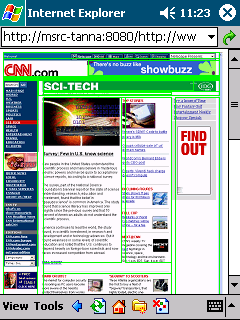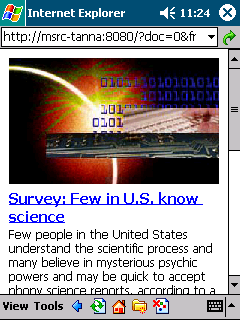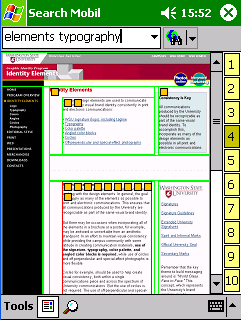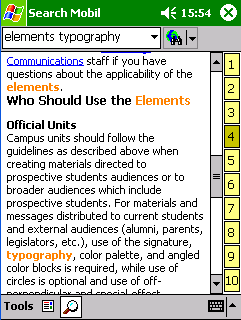

Web pages with complex layout do not display well on the small screens of mobile devices, requiring extensive amounts of scrolling. SearchMobil aims to support Web searching on mobile devices via flexible presentation of pages retrieved by a search engine. A page is partitioned into logical sections whose boundaries are displayed on a zoomed out image of the page. Individual sections are annotated to show the location of the search terms. The user can select a section in order to view it separately from the rest of the page. We carried out a user study to compare SearchMobil's page representation to the one currently used in Pocket Internet Explorer, with a special emphasis on exploring the impact of page structure and query term selection on its effectiveness.
PDA, handheld, mobile device, user interface, searching, browsing, overview plus detail, page viewer, evaluation
Most Web pages are designed with the assumption that they will be displayed on a standard desktop screen. When pages have a complex layout, it can be very awkward to view them on the small screen of a mobile device; typically, extensive amounts of scrolling are required. Restricted view and need for extensive scrolling has been linked to poor performance in information seeking tasks on small devices [2]. To address this problem, authors must create different versions of pages to suit particular target devices, or the Web browsers on mobile devices must be capable of dynamically modifying page appearance.
Generic solutions to the problem of viewing large amounts of information in a small area are known as overview plus detail displays. These enable the user to focus on a selected region, while maintaining a representation of his or her context within the whole, and allowing navigation to other regions of it. We investigated two situations in which the overview plus detail problem arises when viewing Web content on a mobile device: (a) the detail region is a portion of a Web page, and the structure of the page provides the overview for navigation within the page; (b) the detail region is a page in a set of search results (of varying potential relevance) that have been returned from a search engine, and the overview is the set itself.
SmartView [3] is a prototype application that takes a novel approach to the problem of displaying Web pages on mobile devices. It partitions a document into a number of regions, by analysing the layout structure of the underlying HTML. These regions are indicated to the user by superimposed lines on a thumbnail overview of the document, from which he or she can then select a region and read its content in a detailed view (see Figure 1).
 |
 |
SearchMobil extends this approach to support the user in looking for information matching a requirement, in particular when he or she has submitted a query to a Web search engine, and is browsing through the results. It does this in two ways:
These enhancements are facilitated by local or proxy-based processing of the documents retrieved by the search engine. SearchMobil also provides a local search facility, so that the user can carry out a refined search over the set of documents returned by the search engine.
 |
 |
Our initial user study concentrated on evaluating SearchMobil's page representation (comparing it to Pocket Internet Explorer), rather than its booklet interface. Any overview plus detail display is likely to be more suited to some Web page layouts and user tasks than it is to others, presenting challenges for evaluation. As in previous studies of Web browsing on mobile devices (e.g. [1]), we asked our participants to find the answers to set questions at given Web pages. Unlike previous studies, however, we deliberately selected some tasks that did not suit SearchMobil's page representation, in order to explore its advantages and disadvantages. We divided the 12 tasks into three types (6 of type X, 3 of type Y, and 3 of type Z), which we describe in our discussion of the results, below.
We selected 12 questions from the question answering tracks of TREC-9 and TREC-10 [4], which originated from the logs of a Web search engine. For each question, we submitted suitable search terms to Google, and selected one page from the top ten results. The participant was asked to locate the answer to the question on the given page, and was timed with a stopwatch. We had 24 participants: 16 male and 8 female, aged 20-42, all of whom considered themselves to be experienced Web users. We chose a between-subjects design, so half of them viewed the pages in Pocket IE, and half viewed the pages in SearchMobil. All participants did the same 12 tasks, which were presented in a random order on a Compaq iPAQ 3760, running Pocket PC. The answer pages were all cached on the iPAQ, so no network connection was required.
Our dependent variable was the time taken for the participant to locate the answer to the question; this was positively skewed, and so we applied a log transform to it prior to analysis, as is standard. The independent variables were trial (the sequence number of the trial, from 1 to 12), task (the ID of the task, with 12 levels), browser (either IE or SearchMobil), and participant (12 levels for each browser). Applying ANOVA, we found the following:
When selecting tasks for this experiment, it was much easier to find those of type X than of type Y, and finding tasks of type Z was especially difficult. We take this as informal evidence that the SearchMobil strategy is appropriate to the relative frequencies of these types of fact-finding task, but we plan to carry out a more formal survey of Web pages in order to investigate this further.